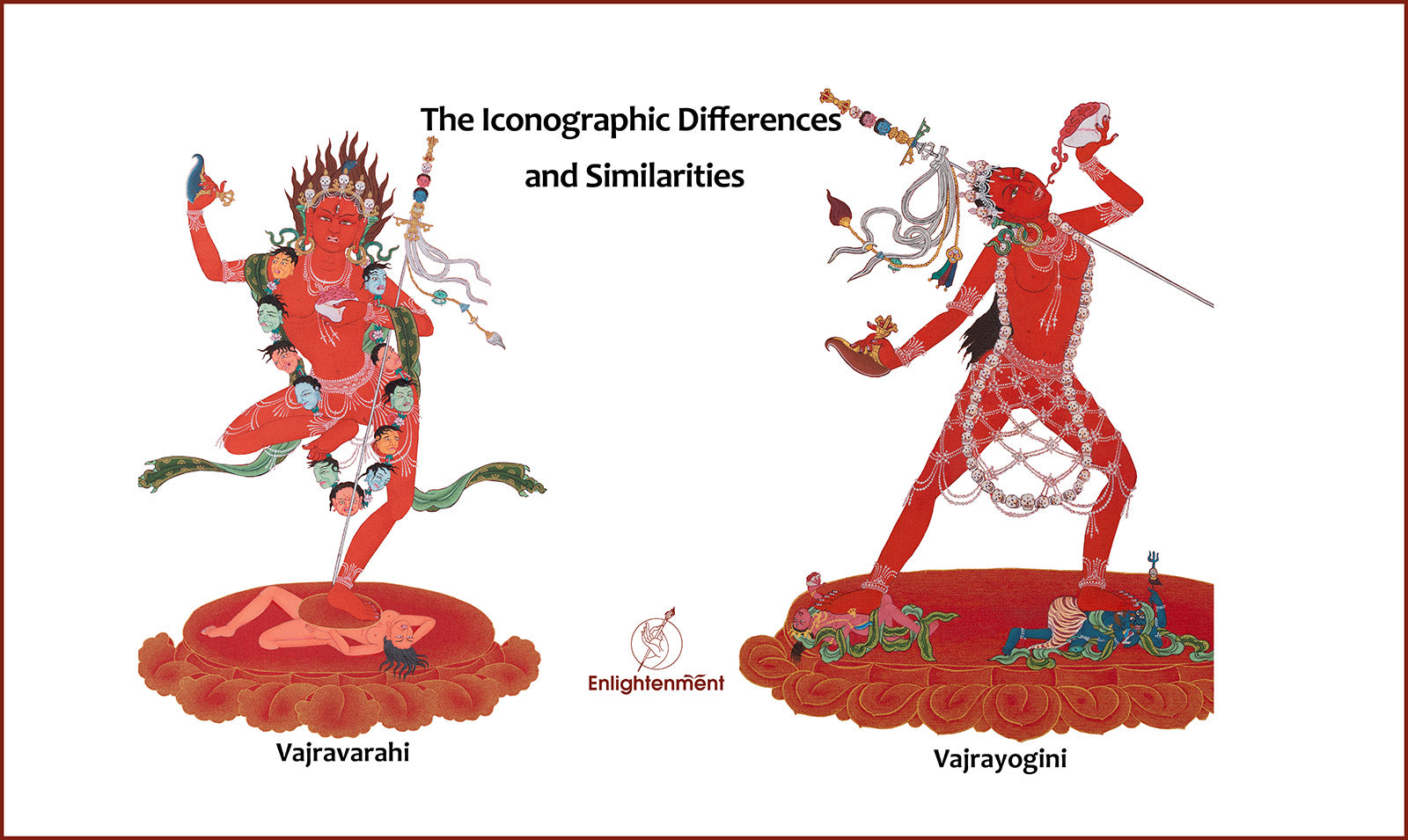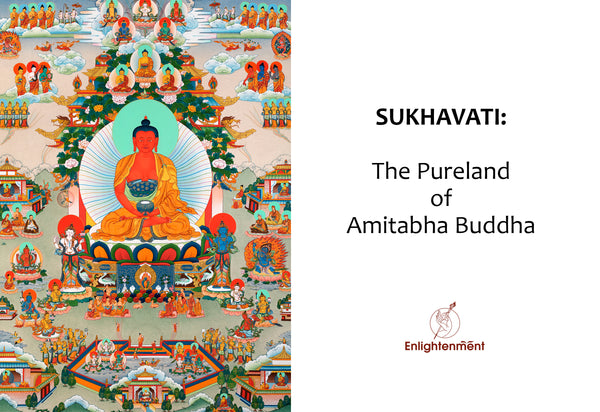Vajrayogini and Vajravarahi as Dakini:
Vajrayogini is an enlightened deity believed to be the manifestation of the wisdom of all Buddhas and is primarily associated with Vajrayana Buddhism. In Sanskrit, Vajra means 'diamond' or 'thunderbolt,' and yogini is a female yoga practitioner.
She represents the path leading to female Buddhahood. She is considered as the ideal figure for Vajrayana practice as she directs one along the path that makes one into an enlightened virtue.
Click here to view our High Quality Vajrayogini Thangka Painting
Vajrayogini possesses three bodies, or degrees of manifestation, as a Buddha. Her ultimate "body" is a formless "truth body" (dharma-kaya) formed of pure light and knowledge. Additionally, she appears in subtle "bliss bodies" (sambhogakaya), the heavenly forms she wears as a deity, attaining enlightenment, imparting wisdom, and motivating people. The third is the "emanation body" (Nirmanakaya) form, which is how she manifests among humans in the physical realm.
She is a Dakini embodying grace and annihilation who dissolves one's ego and illusion. The many elements of her body reflect the foundation we must give up, the spiritual road we must follow, and the outcome we must achieve to reach an utterly enlightened condition. For instance, she is standing atop earthly deities as a sign that she has conquered attachment, hate, and ignorance. Her five ornaments represent the other five perfections of all Buddhas, and her body embodies the knowledge of all Buddhas in its natural state. One of her primary goals is to guide all the sentient beings to Pure Dakini Land. The essence of "great passion" (maharaga), a transcending desire devoid of self-interest and delusion, is Vajrayogini. She puts a great deal of effort into destroying ego and fostering the prosperity of everyone else.
So, Who is Vajravarahi?
Click here to view our High Quality Vajravarahi Thangka Painting
Vajravarahi is called 'Dorje Phagmo' in Tibetan while 'Indestructible (vajra), Sow (varahi)' in Sanskrit. She is the wrathful persona of Vajrayogini.
Her practice is highly significant in the Tibetan Kagyu traditions as a prominent yidam deity and the consort of Chakrasamvara. The sow's head that often appears above or behind her right ear contributes to her distinctive characteristic.
Vajravarahi is often perceived in union with different enlightened figures. While Heruka Chakrasamvara is her primary consort, Hayagriva and Avalokiteshvara are her other two consorts.
Consorts of Vajravarahi:
- Vajravarahi, in a union with Heruka Chakrasamvara [Tib: khrolo Demchog] is depicted as Sahaja Chakrasamvara.
- Hayagriva is a wrathful emanation of Avalokiteshvara. Vajravarahi and Hayagriva are in the union in a form termed Hayagriva Vajravarahi Chintamani [Tib: Tapag Yishin Norbu].
- Vajravarahi is the spiritual wife of Jinasagara [Tib: Gyalwa Gyatso], a form of Avalokiteshvara.
She is revered as the dakini of her primary teachers, such as Marpa, Milarepa, and Gampopa.
Vajravarahi is a Dakini and spiritual force that is said to transform the Five Negative Afflictions, which stand for five impediments that prevent Buddhists from achieving enlightenment through obscuring the actual essence of existence. The Five Afflictions are
- Greed
- Hatred
- Delusion
- Envy
- Pride
Iconographic Differences Between Vajrayogini and Vajravarahi:
Vajrayogini as depicted in Thangka:
She is usually portrayed in blood-red, semi-wrathful form.
Her red body represents life power, the blood of birth, and the raging of her inner fire of spiritual transformation.
Her single face represents her realization that everything has a common root in emptiness.
Her three eyes represent her ability to perceive everything in the past, present, and future, and her two arms represent her knowledge of both realities.
Her right leg is extended, and her left leg is slightly bowed as she holds a skull and a dagger in her right hand (alidha).
The curved knife she carries symbolizes her ability to cut through the continuum of obstacles and delusions that all living things, including her followers.
She drinks the blood from the kapala (skull cup) in her left hand, symbolizing the pure light of happiness that she has experienced. Her entire environment is made up of cremation sites.
Without distorting fiction, it contrasts the rich inner world with its perception of reality.
Vajravarahi as depicted in Thangka:
Vajravarahi is usually depicted with a body red in color, having three penetrating eyes with young, passionate, and semi-wrathful expressions.
She is portrayed with two hands and the same attributes as Vajrayogini, a dagger in the right hand and a skull cup filled with blood overflowing with waves of ambrosia, and a trident in the left.
She stands in a dance position with her left leg stretched in half (diamond posture).
She stepped over a body to represent the defeat of illusions and the triumph over the ego. Her image is frequently seen with flames of ancient wisdom.
Her tawny hair also rushes upward like fire.
She is portrayed with a sow's head on the side of her own as an adornment and some forms she even has a sow's head herself. The pig is a symbol of ignorance in Buddhism. This signifies the victory over the ignorance.![]()
Click here to view our Thangka Collection
Major Similarities in Depiction:
Both are depicted in Ruby red color, radiantly blazing body.
They are standing amidst the blazing wisdom fire and hold the same attribute with their both hands.
Right hand: Curved Knife
Left hand: Skull cup
They hold a khatvanga (topped with Vajra) on their left shoulder which symbolizes their spiritual consort.
Both of them wear the bone ornaments including the skull crown, bracelets, armlets, anklets, waist belt and necklaces.
However, one major difference is that Vajrayogini wears a garland of 50 skulls while Vajravarahi is depicted as adorned with a garland of 50 freshly severed heads.



1 comment
K. Tsuldron
“They hold a khatvanga (topped with Vajra) on their right shoulder”
Do you mean left?